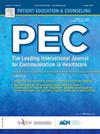在一个测试医疗保健沟通的小插曲实验中,视频小插曲并不比书面小插曲产生更高的参与度
IF 3.1
2区 医学
Q2 PUBLIC, ENVIRONMENTAL & OCCUPATIONAL HEALTH
引用次数: 0
摘要
目的采用实验小插图设计对医疗保健机构的沟通策略进行系统测试。为了确保有效性,这些实验的参与者需要以最佳方式参与假设场景。尽管缺乏证据表明视频的优势,但研究人员通常更喜欢视频而不是书面小短文,以最大限度地提高参与度。我们通过测试视频和书面小插曲形式对癌症患者和幸存者的参与、感知现实主义和焦虑的影响,寻求进一步的证据来证实小插曲形式的选择。方法我们进行了一项实验研究,使用视频和书面小插曲,假设血液学肿瘤的医患会诊。癌症患者和幸存者通过两个小组招募,并通过在线调查参与。主要结果是用户粘性,使用简短的“视频粘性量表”(视频粘性量表的改编版本)进行评估。次要结局是感知现实主义和状态焦虑。结果平均敬业度评分(N = 270)为3.44 (SD=0.77,电位范围1-5)。视频和书面小故事的总体参与度得分、“沉浸感”和“情绪影响”的子量表得分都没有差异。没有发现模态对感知现实主义或状态焦虑的主要影响。参与者的年龄、性别和癌症病史不能预测参与度,而招募来源(小组)可以(p <; .05)。与视频小品相比,书面小品显得同样逼真和身临其境。未来的研究可以确定书面和视频小插曲是否会对其他结果产生不同的影响,以及创新的基于虚拟现实的小插曲模式是否会产生更高的参与度,从而实现更多的互动体验。本文章由计算机程序翻译,如有差异,请以英文原文为准。
Video vignettes do not yield higher engagement compared to a written variant in a vignette experiment to test communication in healthcare
Objectives
Experimental vignette designs are used to systematically test communication strategies in healthcare. To ensure validity, participants of such experiments need to optimally engage with the hypothetical scenario. Researchers have often favored video over written vignettes to maximize engagement, despite a lack of evidence for the superiority of videos. We sought further evidence to substantiate the choice for a vignette modality by testing the impact of video versus written vignette modality on engagement, perceived realism and anxiety among cancer patients and survivors.
Methods
We performed an experimental study using video and written vignettes of a hypothetical physician-patient consultation in hematologic oncology. Cancer patients and survivors were recruited through two panels and participated via an online survey. The primary outcome was engagement, assessed using (an adapted version of) the ‘Video Engagement Scale’ short form. Secondary outcomes were perceived realism and state anxiety.
Results
Mean engagement score (N = 270) was 3.44 (SD=0.77, potential range 1–5). Neither overall engagement scores, nor scores on the subscales ‘Immersion’ and ‘Emotional impact’ differed between video and written vignettes. No main effects were found for modality on perceived realism or state anxiety. Participant age, gender, and cancer history did not predict engagement, whereas source of recruitment (panel) did (p < .05).
Conclusions
Written vignettes appear equally realistic and immersive compared to video vignettes. Future research could establish whether written and video vignettes differentially affect other outcomes and whether innovative virtual reality-based vignette modalities, which enable more interactive experiences, yield higher engagement.
求助全文
通过发布文献求助,成功后即可免费获取论文全文。
去求助
来源期刊

Patient Education and Counseling
医学-公共卫生、环境卫生与职业卫生
CiteScore
5.60
自引率
11.40%
发文量
384
审稿时长
46 days
期刊介绍:
Patient Education and Counseling is an interdisciplinary, international journal for patient education and health promotion researchers, managers and clinicians. The journal seeks to explore and elucidate the educational, counseling and communication models in health care. Its aim is to provide a forum for fundamental as well as applied research, and to promote the study of organizational issues involved with the delivery of patient education, counseling, health promotion services and training models in improving communication between providers and patients.
 求助内容:
求助内容: 应助结果提醒方式:
应助结果提醒方式:


